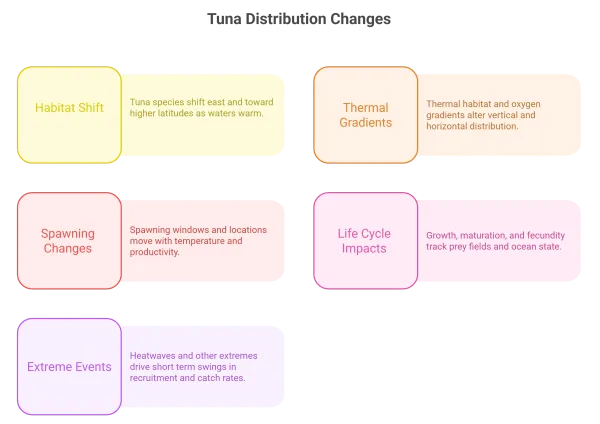Climate Change and Fisheries Management
Climate change reshapes ocean conditions in the Western and Central Pacific Ocean, affecting fish stocks, ecosystems, and fisheries-dependent communities. WCPFC integrates climate into science, management, and compliance to secure long-term sustainability and resilience of tuna fisheries.
Effects on Tuna Species

Skipjack, yellowfin, bigeye, and albacore shift east and toward higher latitudes as waters warm, which changes overlap with fleets. Thermal habitat and oxygen gradients alter vertical and horizontal distribution. Spawning windows and locations move with temperature and productivity. Growth, maturation, and fecundity track prey fields and ocean state. Heatwaves and other extremes drive short term swings in recruitment and catch rates.
Effects on Fishery Operations
Fleets adjust effort and distribution as stocks move, which changes access and costs. FAD drift follows currents and winds, shifting density by area and beaching risk. Catch Per Unit Effort (CPUE) diverges from abundance during environmental anomalies when models lack environmental terms. Stronger storms and coastal flooding increase safety risks. Ports and supply chains face more disruption during extreme events. MCS needs rise as activity spreads across zones and high seas.
Monitoring Priorities
- Sea surface and subsurface temperature, oxygen, and productivity.
- Spawning habitat indices and larval transport.
- FAD positions, soak times, and beaching rates.
- Effort data, CPUE standardization factors, and spatial effort creep.
- Bycatch interactions as overlaps shift.
- Socioeconomic indicators for coastal states and fleets.
Climate Change Workplan (2024–2027)
The WCPFC’s Climate Change Workplan (2024–2027) outlines coordinated tasks across the Commission and its subsidiary bodies to:
- Integrate climate change into science, management, and compliance frameworks.
- Regularly review the Ecosystem and Climate Indicator Report Card.

Enhance data collection and modelling to understand climate impacts.
- Collaborate with other RFMOs and global partners on shared climate challenges.
Implementation
Commission sets policy direction and schedules. Scientific Committee designs indicators, model inputs, and advice. Technical and Compliance Committee addresses MCS and compliance implications. Northern Committee focuses on northern stocks and links to ISC. Secretariat coordinates tasks, timelines, and resources. Members supply data, nominate experts, and support intersessional work.
Milestones 2024–2027
- 2024 - Establish baseline indicators and the report card template.
- 2025 - Publish the first report card and launch the CMM Vulnerability Assessment.
- 2026 - Expand indicators and include climate-conditioned scenarios in scientific advice and MSE trials.
- 2027 - Review delivery and propose the next phase.
Deliverables
- Annual Ecosystem and Climate Indicator Report Card.
- Technical notes on climate inputs for stock assessments and CPUE standardization.
- Guidance for CCMs on data, observer programs, ER, EM, and FAD data for climate analysis.
- Shared tools and joint work items with partner RFMOs and FAO programs.
Regional and Global Collaboration

WCPFC collaborates with other RFMOs and partners such as the Food and Agriculture Organisation and the Inter-American Tropical Tuna Commission to exchange information and strategies in support of climate-resilient fisheries management. Ongoing cooperation includes model development and joint research initiatives.
Current Actions
Share climate workplans and terms of reference with partner RFMOs. Co-finance upgrades to climate-ready modelling, including SEAPODYM. Run joint technical meetings and data exchanges with SPC, ISC, and partners. Coordinate inputs to FAO and UN processes on climate and fisheries.
Outcomes from Subsidiary Bodies
Scientific Committee endorses the Ecosystem and Climate Indicator Report Card and requests environmental terms in assessments and CPUE standardization. Northern Committee maintains climate as a standing item and requests ISC to report climate signals for northern stocks. Technical and Compliance Committee notes compliance risks under shifting distributions and requests analysis of MCS implications and data needs. Small working groups and SMD processes support capacity for SIDS and territories on data, analysis, and planning. The Commission endorses the Terms of Reference for the CMM Vulnerability Assessment and a staged schedule starting 2025.
Support for CCMs
Nominate focal points for climate tasks and expert groups. Share national data for indicators, including ER, EM, and FAD data. Integrate climate risk into harvest strategy positions and national plans. Strengthen observer safety, port contingency plans, and supply chains for extreme events. Seek partnerships and funding for climate monitoring and analysis.
Key Projects and Research
WCPFC-funded projects support climate resilience and the scientific basis for management.
| Project 121 - Ecosystem and climate indicators | Develops a suite of indicators for the WCPO. Refines climate and ocean models to improve projections. Establishes an annual Ecosystem and Climate Indicator Report Card. |
| Projects 117 and 118 - Biological sampling of tuna and billfish | Designs structured sampling plans for key species. Uses power analysis and simulations to set sample sizes. Audits and leverages the Pacific Marine Specimen Bank. |
| Project 120 - Reproductive biology baselines | Builds baseline reproductive parameters for tunas, with an initial focus on yellowfin. Processes historical gonad samples and tests complementary methods. Maps spatial differences in reproductive potential. |
| SEAPODYM | Advances a spatial ecosystem and population dynamics model for tuna. Integrates environmental data with biology to project distribution and abundance under climate scenarios. Supports management strategy evaluation and adaptive planning. |
| Project 123 - Next-generation stock assessment tools | Scopes and develops new stock assessment software to succeed MULTIFAN-CL. Reviews global platforms and defines WCPFC needs. Plans a multi-year transition to a more flexible framework. |
| CMM Climate Change Vulnerability Assessment | WCPFC will evaluate CMMs under climate stress, rate risks, identify data needs, consult SC, TCC, NC, and CCMs, and deliver staged outputs to strengthen tuna, FAD, observer, ER or EM, spatial, bycatch, port state, and transshipment measures. |